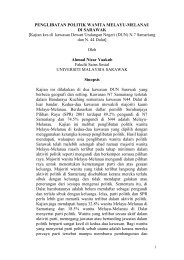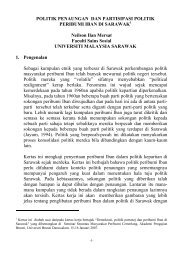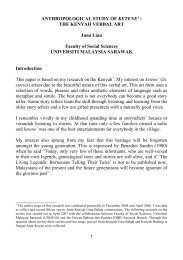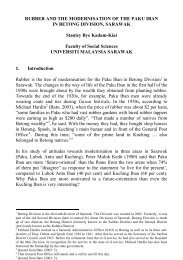OF SOUKHUAN AND LAOS Elena Gregoria Chai Chin Fern Faculty ...
OF SOUKHUAN AND LAOS Elena Gregoria Chai Chin Fern Faculty ...
OF SOUKHUAN AND LAOS Elena Gregoria Chai Chin Fern Faculty ...
You also want an ePaper? Increase the reach of your titles
YUMPU automatically turns print PDFs into web optimized ePapers that Google loves.
Soukhuan is mainly performed by the Lao Loum, who are mostly devout Buddhists.<br />
As interaction and inter-marriages between the different ethnic groups is on the rise<br />
now, it is not uncommon to see the Lao Theung or Lao Sung attending such<br />
ceremonies. The specialist of the rite is known as Mor Phon, an elderly man who has<br />
been ordained as a monk before. Therefore, the role of the specialist is confined to<br />
Buddhist devotees, the Lao Loum. Everyone, including other nationalities are<br />
welcomed to join in the ceremony. It is also not unusual for Lao employees or friends<br />
to hold soukhuan ceremonies for their foreign colleagues who are leaving the country.<br />
Apart from Soukhuan, other soul calling methods include Wankhuan and Sornkhuan,<br />
as elaborated further in this paper.<br />
The soukhuan ceremony is held all over Laos. There are actually considerable<br />
differences in the details of the ceremony from one province to another. Nevertheless,<br />
there is also a similarity of form. For example, the paraphernalia of the ceremony<br />
differs greatly. In Sekong province, the mak beng is sometimes made from newspaper.<br />
Mak beng is a cone shaped structure usually made from banana leaves and is placed in<br />
a silver or golden bowl, which itself is placed on a huge tray to create the Phakhuan,<br />
the main item of the soukhuan ceremony. ‘Pha’ means table and Phakhuan indicates<br />
the table of the khuan. It is at this table that the khuan will gather. The silver or golden<br />
bowl with the mak beng is usually filled with raw glutinous rice and five types of<br />
auspicious leaves.<br />
The role of rice<br />
Rice, the staple food for East Asian, South Asian and Southeast Asian is not just a<br />
food item but is rich in symbolism. It is viewed as a life-giver from god and is an<br />
inseparable life force. Rice symbolizes survival and sustenance and therefore, is<br />
worshipped and glorified in many rice-growing countries. However, sticky rice (kaw<br />
niow) or glutinous rice occupies a special position above the normal rice (kaw jau).<br />
Not only Lao people eat sticky rice as their staple food, the <strong>Chin</strong>ese and Japanese also<br />
use sticky rice extensively in rituals.<br />
The Japanese place ‘mochi’ (made from mochi gome: - sticky rice) on the front<br />
gate or doorway as an offering to the god on New Year day. Then on the 11 th day of<br />
the New Year (used to be the 20 th day), known as the ‘Kagami Biraki’ day, the mochi<br />
is ‘opened’. It is actually a process of cutting but the word ‘cut’ is prohibited on<br />
auspicious occasions. After it has been opened, the mochi is cooked and eaten by<br />
every member of the family. For the <strong>Chin</strong>ese, on the 24 th day of the 12 th lunar month,<br />
every household will prepare a kind of sweet cake made from Nouk Mi (sticky rice)<br />
and sugar to be offered to the Kitchen God before he ascends to heaven to report on<br />
the behaviour of family members to the Emperor God. It is hoped that the sweet cake<br />
will appease the Kitchen God and he will convey good messages to the Emperor God.<br />
- 11 -<br />
PDF Creator - PDF4Free v2.0<br />
http://www.pdf4free.com







